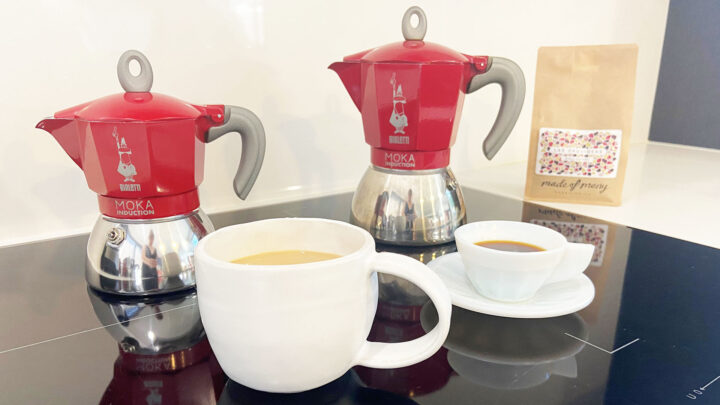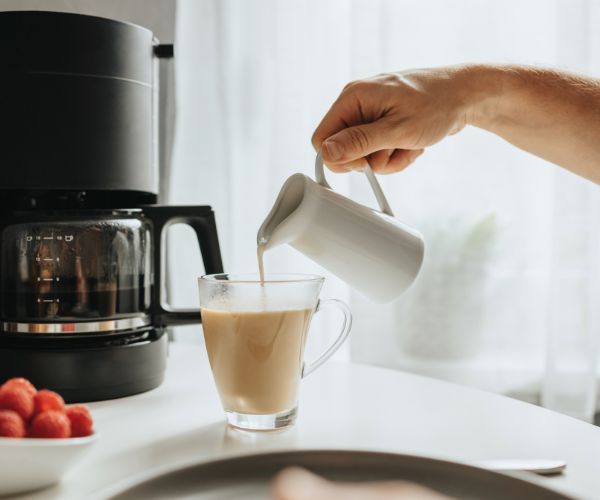I have been using Bialetti’s Moka Pots on and off for more than two decades. It had a resurgence in my household during the Covid lockdowns and I was reminded just how much I enjoy the unique flavour of a stove top coffee. It’s a whole different coffee experience to my usual flat white, and quite a bit cheaper! Having moved from a house with a gas stove top to induction, I was making do with a traditional moka pot on a simmer mat. Ouch! Hot! The things we did for a decent cup of coffee during those crazy times (aforesaid method NOT recommended)! So when I read about this new induction-specific model I had to buy one. Well, two actually!
Women’s Weekly Food’s Moka Pot Induction 4-cup review verdict
Good for: Time poor coffee lovers who want to make a strong brew at home with a minimum of fuss. It’s a good option for the budget-conscious, too.
Pros
- Makes a strong cup of coffee quickly.
- It’s easy to use and clean.
- Produces a consistent end result.
- The design. It’s stylish and fun and would not look out of place if it had to reside on your kitchen bench or stovetop.
Cons
- The machine gets hot, making it tricky to make multiple pots of coffee if you have guests over.
- You need to keep an eye on it when it’s on the hob and turn it off when it stops spluttering so the coffee doesn’t burn.
- If you open the lid while it’s brewing it will splutter.
What’s so special about the Moka Pot Induction?
This stylish stove top coffee maker produces a strong cup of coffee with ease and minimal clean-up.
- Makes a strong, smooth cup of coffee. Option to purchase a home coffee pot sized for two, four or six cups. We road tested the 4-cup and 6-cup.
- Specifically designed for an induction stove top, but also works on gas and electric. I regularly take mine on holiday with a bag of ground coffee.
- It’s easy to clean. Bialetti recommends not using the dishwasher. As tempted as I have been to bung it in there, I’ve respected the advice and found the coffee maker’s three parts easy to clean. The instructions recommend just using water, not detergent. The worst bit is getting the used coffee grounds out of the filter. I still haven’t managed to do it without spilling some on the bench.
- The streamlined design comes in two colours, red or black, with the trademark octagonal base and lid, and the Bialetti logo of the moustachioed man printed on the outside and stamped into the top of the filter basket. It was first designed in Italy in 1933 by Alfonso Bialetti.
.
Moka Pot Induction materials and size
- It can be purchased in three sizes – two, four or six cups.
- The moka pot consists of three components. The “heater” aka the base or boiler, is where the water is stored. This consists of an external layer of steel designed for induction hobs and an internal layer of aluminium alloy. The “filter funnel” which houses the ground coffee, and the upper part which captures the brewed coffee and is made from food-grade aluminium alloy.
- The base has a safety valve. Ensure this is pointed away when brewing.
- The moka pot gets quite hot but the handle and top knob are heat proof.
- The moka pot is compact and easily stored in a kitchen cupboard – or if you use it daily as I do – store it on the switched off stove itself. I matched the colour of mine to the rest of my on-bench appliances.
How to use the Moka Pot Induction
The induction moka pot is quick and easy to use. Follow these steps and tips for a lovely, rich cup of espresso:
- Fill the base with cold water up to the bottom edge of the safety valve.
- Place the filter into the base. If water bubbles into the filter there’s too much in there! Fill the filter basket with coffee ground specifically for a stove top coffee maker. Fill the basket to the top but do so lightly. Do not press the coffee down! Wipe around the rim of the basket to remove any wayward grounds.
- Screw on the upper part. Don’t screw it on too tightly! I did this the first time and when the base was empty it started squealing like an old fashioned kettle! It also made it hard to unscrew.
- Place the moka pot on the induction hob and heat. The manual says not to use the highest heat, but to use a medium setting for induction.
- When the water boils, it starts bubbling up the funnel, through the ground coffee, and up into the jug. You’ll hear it spluttering out. When the spluttering noise stops and the jug is full of coffee, turn off the heat straight away and remove it from the heat source. Keep the lid closed while it is brewing or you’ll have spluttered coffee to clean up!
- The instructions recommend giving the coffee in the jug a stir before pouring. I’ve never done this! Something to try next time. The base of the pot will be very hot, so use the handle to transport and be careful where you sit it down.
Note: Before you begin, Bialetti recommends running through the process with just water in the machine followed by three rotations with just coffee (disposing of each brew).
Results from our test
I love this little machine. It produces a consistent coffee quickly with a minimum of fuss. I like a milky coffee, and find it produces a strong drop, so I add a bit of milk. One limitation is the machine gets very hot, so if you have guests over and need to brew another pot, you’ll need to let it cool down a bit before cleaning out the funnel and refilling. It is for this reason I own the Moka Induction in two sizes – a four cup and six cup. The four cup produces 150ml of coffee, which my partner and I share.
What do the experts think about the Moka Pot?
Women’s Weekly’s Food Director Fran Abdallaoui is a long time user of a Moka Pot.
“I love the Moka as you can adjust the amount of water to make either an intense espresso or a lighter longer coffee,” she says.
“The size and portability of the moka pot are a great advantage as I take it camping or to an Airbnb, ensuring a great coffee wherever you are. The only slight disadvantage I’ve found is you need to pay attention while you’re brewing the coffee as it does tend to spurt and splutter if it’s overboiled.”
Abdallaoui’s pro-tip for getting the most out of your Moka Pot:
“As with any coffee maker, it’s all about the quality and freshness of the coffee beans and the right grind so it does take a little experimentation to master the perfect cup to suit your taste.”
Overall, is Moka Pot Induction worth it?

I love coffee. Adore it. As such, I have owned a lot of different coffee making equipment over the years, from drip filter and espresso machines to plungers. Including a few Moka Pots (see image above!). As a time poor working parent, the Moka Pot is an absolute favourite for this stage in my life when I’m making coffee at home. It is easy to use, quick to make and straightforward to clean. Best of all, it makes a lovely cup of coffee.
Where to buy Moka Pot Induction
- Amazon, Moka Induction 4-cup (red), $62.59
- David Jones, Moka Induction 4-cup (black), Now $76.96 (usually $109.95)



